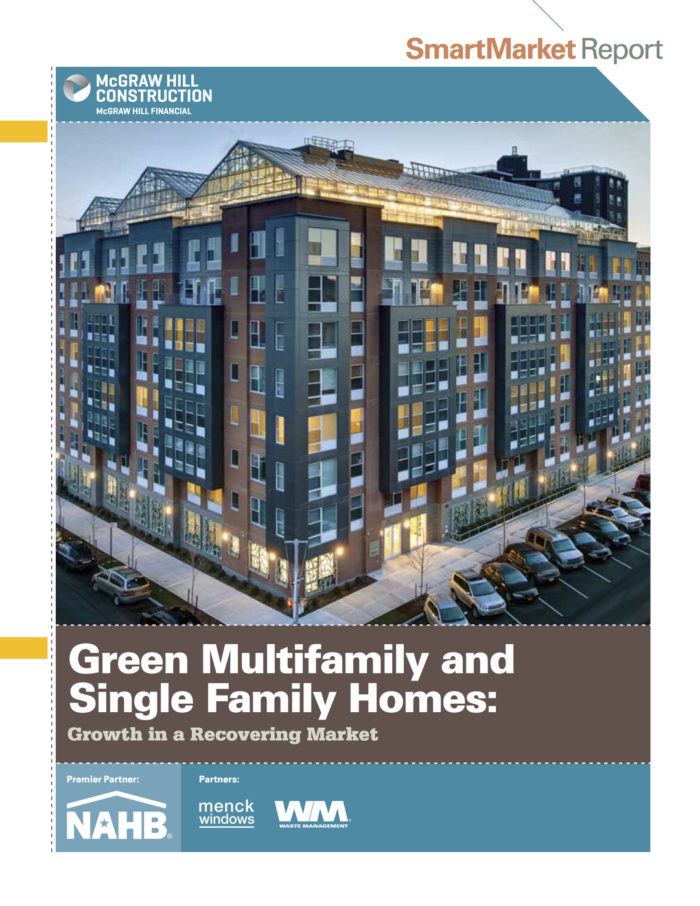
Image Credit: McGraw Hill Construction
Increased buyer interest in green building is helping to make it a more important part of the housing market, according to a new study by McGraw Hill Construction.
The percentage of builders of single-family homes who said that more than 90% of their projects are green grew from 12% in a 2011 study to 19% this year, and is projected to rise to 38% by 2018. The percentage of builders who said that less than 16% of their projects were green shrank proportionally, from 63% in 2011 to 38% in the most recent study. That number should fall to 16% by 2018.
“These findings demonstrate that among home builders, and increasingly among single-family remodelers, green is becoming the standard way to build,” the report said. “This wider adoption of green may help push the single-family home market to become even greener in the future, with homes increasingly needing to be green to be competitive.”
By 2016, the report says, green single-family homes will represent between one-quarter and one-third of the market, “translating to a $80 billion to $101 billion opportunity based on current forecasts.”
In multifamily construction, the number of builders making more than 90% of their projects green was much lower than on the single-family side, remaining at a flat 6% between 2011 and 2013 and projected to grow to an estimated 18% by 2018. Those making less than 16% of their projects green dropped from 69% in 2011 to 46% in 2013. That was expected to decline to 21% by next year.
The authors concluded that while more multifamily builders are becoming experienced with green practices, they are not choosing to specialize in it.
These results are based on an online survey of 116 single-family home builders, developers, and remodelers, McGraw Hill said, along with 38 multifamily builders, developers, and remodelers. The survey was conducted over a four-month period from December 2013 to March of this year.
A “green” home was defined as “one that incorporates environmentally sensitive site planning; resource efficiency; energy and water efficiency; improved indoor air quality; and homeowner education or projects that would comply with the ICC 700 National Green Building Standard or other credible rating system.”
A variety of factors aiding the move to green
Builders and developers said that the three most important factors in their adoption of green building strategies were increasing energy costs, changes in codes and regulations, and wider availability and lower prices for green building products.
Builders also found that more buyers were willing to pay higher prices for a green home in 2013 than in 2011. The percentage of single-family builders who said that customers would pay more grew from 61% in 2011 to 73% in 2013. On the remodeling side, that grew from 66% to 79%.
The number of builders incorporating renewable energy systems into their projects also is on the rise. In 2013, 8% of builders surveyed said they included renewables on all of the projects, which was expected to grow to 20% by 2016. The proportion of builders offering renewables as an option was 34% in 2013 but expected to increase to 40% by 2016.
One source of frustration for both homeowners and builders has been that green features aren’t always recognized by real estate appraisers or lenders, a situation that may be slow to change. The report says that appraisers now have better tools at their disposal, but adds that a relatively small number of multiple listing services — 185 of the country’s nearly 850 total — provide fields where information about green building features can be added.
One Florida banker was quoted as saying that many appraisers show limited interest in making green features part of their reports.
There are many other details available in the 64-page report, which can be downloaded for free. (If you don’t already have an account with McGraw Hill you’ll have to create one to get access to the report.)
Weekly Newsletter
Get building science and energy efficiency advice, plus special offers, in your inbox.














2 Comments
sigh
Isn't this the sort of thing that should be freely available,
to encourage the right trends in the industry? Can the
document be copied and made available here or something, so
anyone curious about it doesn't have to give away yet more
personal information and remember yet another stupid password?
"Signup-wall" schemes just to download "free" information are
perhaps *the* most misguided out there.
_H*
Reply to Hobbit
Hobbit,
I understand your frustration. As you probably know, however, GBA has nothing to do with McGraw Hill, and the company presumably has the right to release their report for free, or to sell it for $1,000 a copy, or to release it only to those who sign up on their website -- just like any other publisher.
Log in or create an account to post a comment.
Sign up Log in